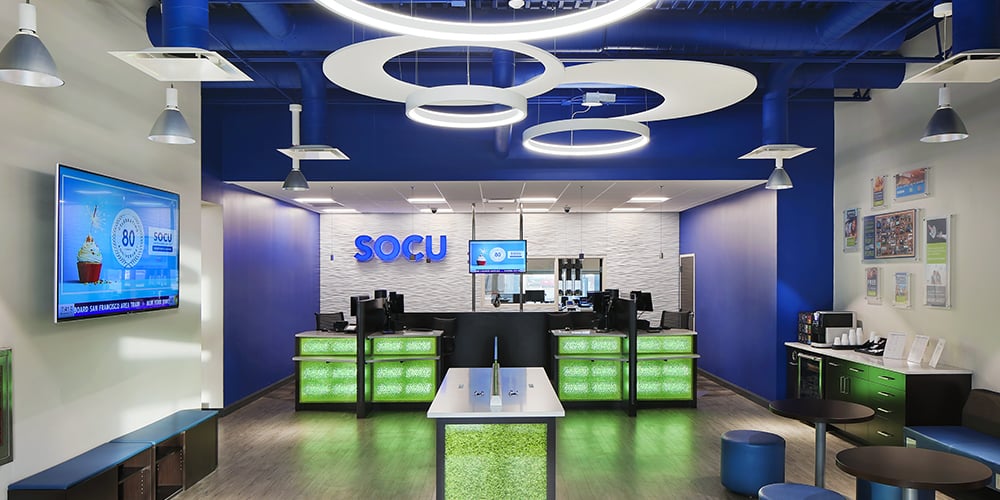Leveraging technology to enhance branch health and safety

When it comes to the consumer journey, the branch banking experience has looked and felt the same for decades, and consumers were accepting of that. But, even before COVID-19, things were starting to change. In recent years, consumers have come to expect the same high-tech amenities at their banks and credit unions as they experience in other retail environments, balanced with the in-person, community-based financial expertise that occurs face-to-face in the physical branch. As “shelter at home” orders expire and branches across the nation reopen, not only will there be a continued need to balance the high-tech with the individualized, personal-relationship, but there will be a need to adapt in direct response to the wants and needs of the post-pandemic consumer.
As a result, financial institutions must consider modifications that prioritize public health and safety – in a way that eases any fears, and projects a sense of security, safety and well-being for consumers and employees alike. There are multiple, baseline modifications branches can and should consider before reopening. Which solutions are right for each branch will be dependent on multiple factors, including the local impact of the pandemic and consumer sentiment. Simple modifications, like floor markers, acrylic partitions and sanitization stations, meet the immediate need and are critical to a reopening strategy; however, as we look to the branch of the future, we have an opportunity to seamlessly integrate these and more advanced safety elements to ensure a comfortable experience for the consumer. Through creative, adaptable design, a relationship-based, high-tech, AND high-safety branch can and should feel natural.
Institutions will need to communicate digitally that they are ready for employees and patrons to return and will need to quickly demonstrate that they have created spaces and environments that prioritize public health and safety. Imagine a branch designed for social distancing, with the consumer journey mapped and managed to seamlessly control spacing and interaction. Members and employees enter through automatic doors, never having to touch a handle. Copper alloy surfaces that are anti-microbial as well as functional and aesthetically pleasing adorn properly spaced consultation stations. In a space drenched in natural sunlight, UV-based disinfecting systems target high-touch, high-traffic areas. Enhanced HVAC filtration systems continuously maintain the air quality of the physical space behind-the-scenes. These types of changes are key to the branch of the future, but there are even more things financial leaders can do.
Understandably, much attention is being paid to the safety of the physical branch and the changes that will come. However, it’s important to consider how all your banking channels work together to promote and protect safety. Now may be the time for a paradigm shift. Rather than physical vs digital channels, what if we looked at technology, including digital, as a foundational strategy to support and connect in-person service, remote service and self-service? Would that enable financial leaders to more readily adapt to whatever challenges come their way?
Looking ahead, technology will enable a better, safer branch experience and is key to integrating self-service and in-person service specifically. With a fully tech-enabled journey, should a member want or need to visit a branch for something like opening an account or refinancing a loan, being able to schedule an appointment online will help to manage their time and expectations, and control branch traffic. Enhancing that experience one step further, digital queuing enables staff to alert members waiting in the parking lot when it is safe to enter the lobby.
In the not-so-distant future, once a member enters the branch, digital signage populated by a content management program can highlight the various ways the branch has been modified for their safety and include messaging on best-practices for in-branch interaction. That content can easily be changed to feature promotions, new perks and even local community events. During scheduled meetings, there will likely be an even greater desire to minimize the time physically spent in the branch, and a digital strategy that enables members to start something online (new account activation, a loan, etc.) and seamlessly continue the conversation in-branch will be highly valued. For simple transactions, many ATMs can handle withdrawals and deposits, while an upgrade to or the addition of ITMs connected to core systems can help maintain physical distancing while providing personalized support via a remote video operator. These are just a few of the many changes credit unions can make to create a better, safer experience by positioning digital or technology strategies at the center of their universe.
There is no crystal ball showing us what the future holds. An investment in your future involves both quickly and effectively modifying your space to meet the immediate needs of today’s post-pandemic consumer, while keeping an eye toward investments that allow you to easily adapt to what the future might bring. The institutions that adapt will be the ones that thrive.

